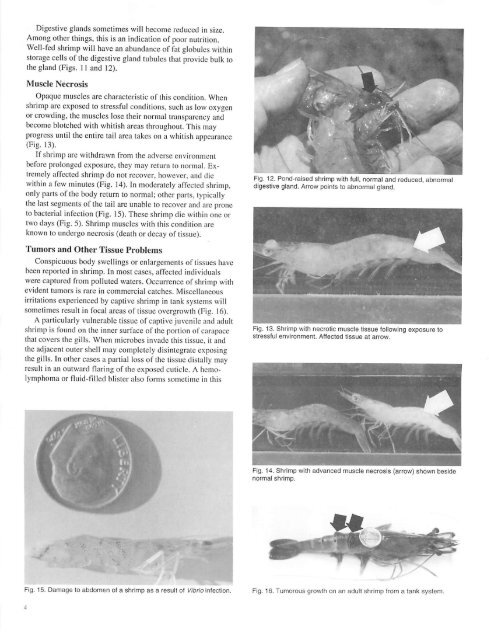Handbook of Shrimp Diseases - the National Sea Grant Library
Handbook of Shrimp Diseases - the National Sea Grant Library
Handbook of Shrimp Diseases - the National Sea Grant Library
You also want an ePaper? Increase the reach of your titles
YUMPU automatically turns print PDFs into web optimized ePapers that Google loves.
Digestive glands sometimes will become reduced in size.<br />
Among o<strong>the</strong>r things, this is an indication <strong>of</strong> poor nutrition.<br />
Well-fed shrimp will have an abundance <strong>of</strong> fat globules within<br />
storage cells <strong>of</strong> <strong>the</strong> digestive gland tubules that provide bulk to<br />
<strong>the</strong> gland (Figs. 11 and 12).<br />
Muscle Necrosis<br />
Opaque muscles are characteristic <strong>of</strong> this condition. When<br />
shrimp areexposed tostressful conditions, such as low oxygen<br />
or crowding, <strong>the</strong>muscles lose<strong>the</strong>ir normal transparency and<br />
become blotched with whitish areas throughout. This may<br />
progress until <strong>the</strong> entire tail area takes on a whitish appearance<br />
(Fig. 13).<br />
If shrimp arc withdrawn from <strong>the</strong> adverse environment<br />
before prolonged exposure, <strong>the</strong>y may return to normal. Ex<br />
tremely affected shrimp do not recover, however, and die<br />
within a few minutes (Fig. 14). In moderately affected shrimp,<br />
only parts <strong>of</strong> <strong>the</strong> body return to normal; o<strong>the</strong>r parts, typically<br />
<strong>the</strong> last segments <strong>of</strong> <strong>the</strong> tail are unable to recover and areprone<br />
to bacterial infection (Fig. 15). These shrimp die within oneor<br />
two days (Fig. 5). <strong>Shrimp</strong> muscles with this condition are<br />
known to undergo necrosis (death or decay <strong>of</strong> tissue).<br />
Tumors and O<strong>the</strong>r Tissue Problems<br />
Conspicuous body swellings or enlargements<strong>of</strong> tissueshave<br />
been reported in shrimp. In most cases, affected individuals<br />
werecaptured from polluted waters. Occurrence<strong>of</strong> shrimp with<br />
evident tumors is rare in commercial catches. Miscellaneous<br />
irritations experienced by captive shrimp in tanksystems will<br />
sometimes result in focal areas <strong>of</strong> tissue overgrowth (Fig. 16).<br />
A particularly vulnerable tissue <strong>of</strong> captivejuvenile and adult<br />
shrimp is found on <strong>the</strong> inner surface <strong>of</strong> <strong>the</strong> portion <strong>of</strong> carapace<br />
that covers <strong>the</strong> gills. When microbes invade this tissue, it and<br />
<strong>the</strong>adjacent outershell maycompletely disintegrate exposing<br />
<strong>the</strong>gills. In o<strong>the</strong>rcases a partial loss<strong>of</strong> <strong>the</strong> tissue distally may<br />
result in an outward flaring <strong>of</strong> <strong>the</strong> exposed cuticle. A hemolymphoma<br />
or fluid-filled blister also forms sometime in this<br />
Fig. 15. Damage to abdomen <strong>of</strong> a shrimp as a result <strong>of</strong> Vibrio infection.<br />
Fig. 12. Pond-raised shrimp with full, normal and reduced, abnormal<br />
digestive gland. Arrow points to abnormal gland.<br />
Fig. 13. <strong>Shrimp</strong> with necrotic muscle tissue following exposure to<br />
stressful environment. Affected tissue at arrow.<br />
Fig. 14. <strong>Shrimp</strong> with advanced muscle necrosis (arrow) shown beside<br />
normal shrimp.<br />
Fig. 16. Tumorous growth on an adult shrimp from a tank system.















